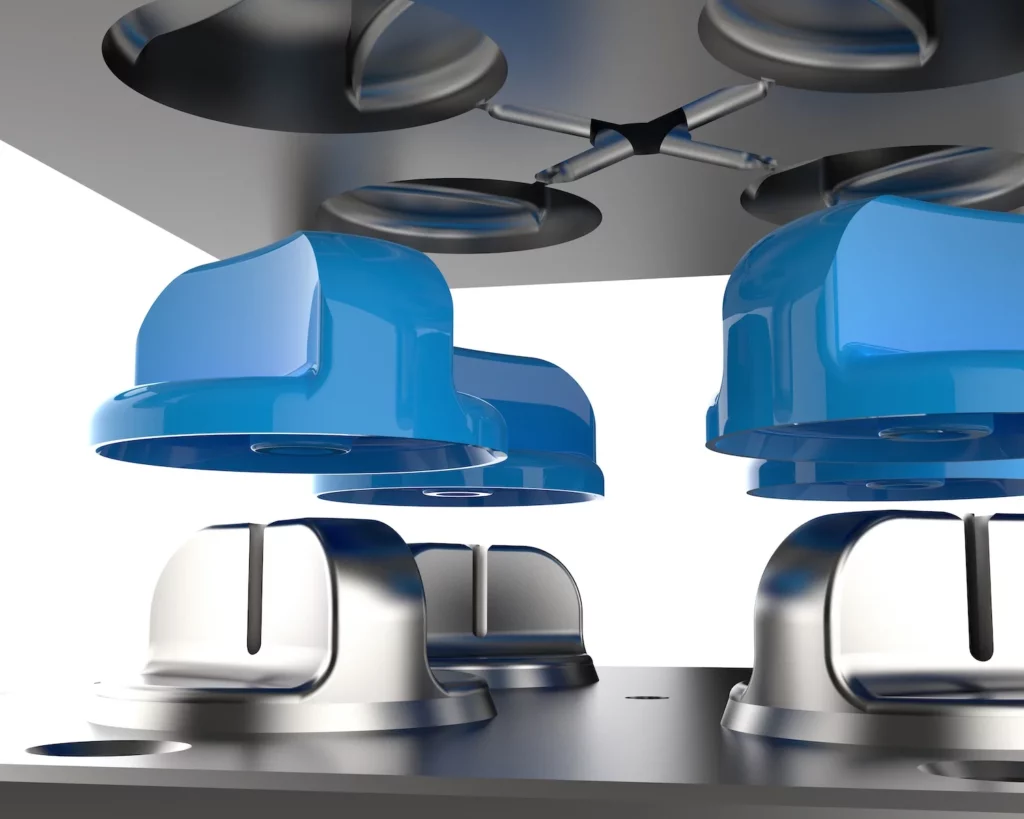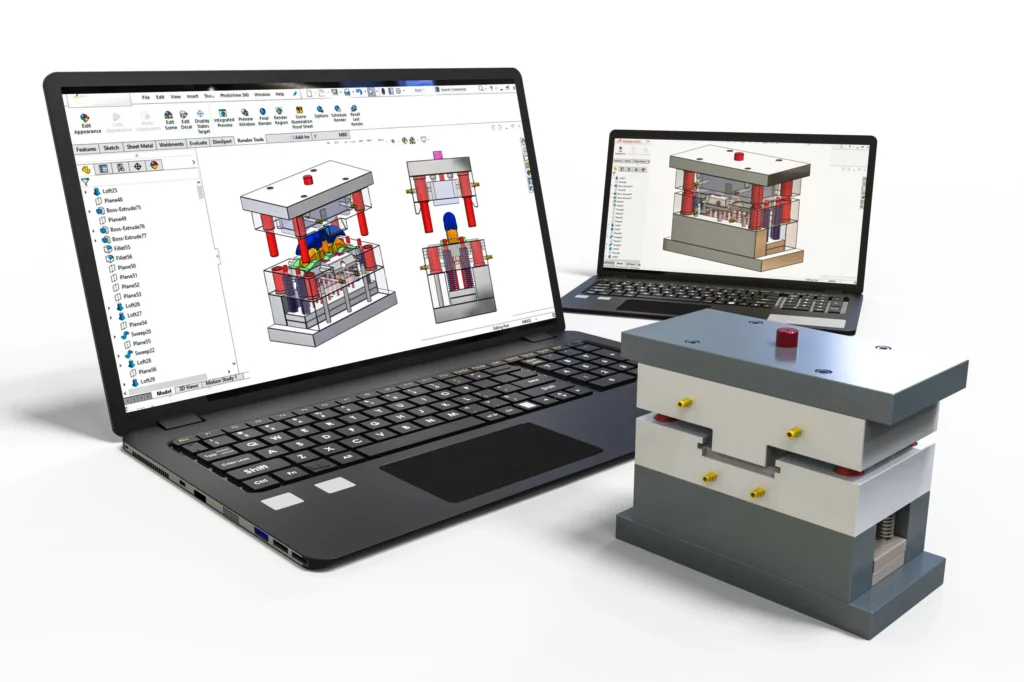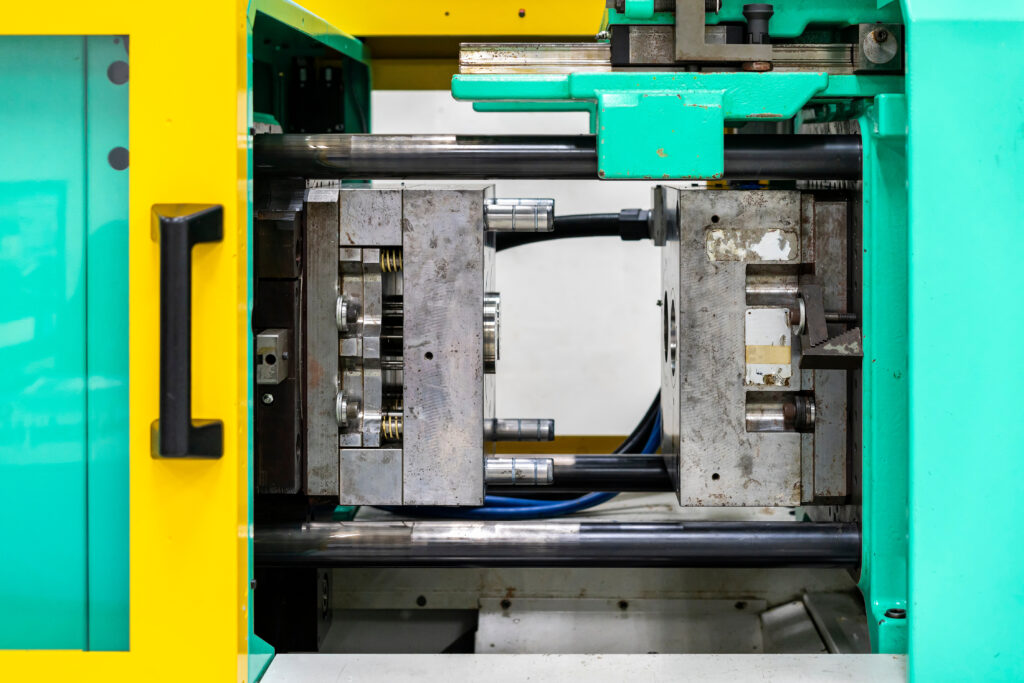Strona główna » Injection molds » Construction of injection molds
Injection molds consist of many systems and components that must be carefully designed and manufactured with great accuracy. This is because injection molding (the process of manufacturing parts that uses injection molds) puts molds through very harsh working conditions, such as high temperature and high pressure during batch or mass production.
An injection mold is like the negative of a photograph, meaning its geometry and surface texture are directly transferred to the injected part. The main task of the injection mold is to make this mapping without any deformation as many times as possible.
The construction of the mold is intended to ensure the aforementioned goal. It consists of two halves: the cavity (front) and the core (rear).
For more complex geometries (containing a cavity, or holes) it is necessary to use movable side cores, or other inserts. These are moving parts that enter the mold from top to bottom. Their downside is that they increase the cost of producing an injection mold.
The molds can be single-cavity, or multi-cavity. The number of slots defines the number of products that are produced in one production cycle and affects the price of the mold, but also its productivity.



The injected parts have two sides: side A, which is opposite the cavity (the front half of the mold), and side B, which is opposite the core (the back half of the mold). The two sides usually perform different functions:
Side A – usually has a better visual appearance and is often called the cosmetic side. The surfaces on page A will be smooth or textured according to your design requirements.
The B-side usually contains hidden (but very important from the production side) structural elements of the part (e.g., hooks, ribs, latches, etc.). For this reason it is called a functional site. The B-side will often have a rougher finish and visible ejector stamping marks. This is not a problem, as these marks will not be visible on the manufactured ironing.
The channel system is designed to guide the molten plastic into the mold cavity. It controls the flow and pressure with which the liquid plastic is injected into the socket, and is then removed after pushing out (pulls off). The duct system usually consists of 3 main sections:
1. Main gate is the main channel through which all the molten plastic entering the mold initially flows.
2. a dispersion channel (or, for example, a flow channel) distributes molten plastic along the surface where the two halves of the mold meet. There may be one or more scatter channels, leading material to one or more parts. The duct system is cut off from the part after stuffing. It is the only material waste in injection molding, of which 15-30% can be recycled and reused. It will also be possible for the resulting lint to be removed. With a GK (hot-channel) system, there is nothing left to remove, only with a ZK (cold-channel) system.
3. the point of entry of the material into the mold cavity – it is very important because of its geometry and location, as it determines the flow of plastic.
A properly functioning gating system makes it possible to obtain products with the same properties from each nest.
Where the channel system connects to the manufactured part, a small imperfection, called an injection point remnant, is usually visible. If the presence of this imperfection is not desirable for aesthetic reasons, it can also be “hidden” on the functional side B of the part.
At the end of the injection molding machine is a clamping system. The clamping system has a dual function: it keeps both parts of the mold tightly closed during injection molding and pushes the part out of the mold when it is opened. After the part is pushed out, it falls onto a conveyor belt or into a bucket for storage, and the cycle begins again.
Alignment of the various moving parts of the mold is never perfect. This results in two common imperfections that are visible on almost every injected part:
1. separation lines, which are visible on the side of the part where the two halves of the mold connect. They arise from minor inconsistencies and slightly rounded edges of the mold.
2. ejector marks (or witness marks) that are visible on the hidden B side of the part. They arise because the ejector pistons are slightly protruding above or depressed below the mold surface.
Another function of the injection mold is to dissipate heat from the hot liquid plastic and to enable the removal of molded parts in a fast and reproducible manner. About 50% of a typical injection molding cycle is devoted to cooling and curing. Therefore, minimizing the thickness of the design is key to speeding up this step and reducing costs.
The purpose of this system is to cool the molded part to such a temperature that it can be removed from the mold. The freshly injected plastic reaches high temperatures, even over 200 degrees Celsius.
To ensure rapid and even cooling of the product, cooling channels are built into the mold.
In addition to those mentioned above, an injection mold consists of several other key components that work together to give the plastic the desired shape. Proper design of injection molds is key to achieving optimal results. Each of these components plays an important role in the molding process, and their precise execution and proper operation are crucial to the quality of the final product.
The mold consists of two main plates – a movable and a fixed one. A fixed plate is attached to the injection molding machine, and a movable plate opens and closes the mold. These plates house the mold halves that define the shape of the manufactured part.
The molding plate, is the base on which the rest of the injection mold components are stored and closed. It must be made of a strong material, such as tool steel, to withstand the high injection pressure and ensure the stability of the mold structure. The precision of the molding plate is crucial to the quality of the final product, as any unevenness can lead to defects on the moldings.
Another important component of the injection mold is the molding cavity, which gives the final shape to the product. The making of the mold, including the surface finish, is key to ensuring the quality of the product surface and the proper flow of material in the mold.
The mold cavities define the target shape of the part. There are several forming surfaces, including. Stamp, die or moveable segments. We distinguish between single-cavity, or multi-cavity forms. The number of molding slots determines how many moldings can be produced in one production cycle.
Designing a molding cavity requires consideration of material shrinkage to avoid defects in molded parts, such as overblowing or underblowing.
The metal housing serves a protective function by protecting the inside of the injection mold.
Material selection plays an important role. The injection molds are built from high-quality steel, which is selected individually depending on the project. The most common steels are alloyed, tool or stainless steels, which are characterized by high strength. In order to choose the right type of steel, it is necessary to take into account what plastic we are going to make products out of, their intended use and the assumed number of production cycles.
The materials from which injection mold components are made must withstand high temperatures, pressure and abrasion.
Less expensive aluminum molds are used in short production runs (up to a few thousand units at most).
Choosing the right material is therefore important for the efficiency of the injection molding process and the quality of the final product.
We can equip the injection mold with cold-channel (ZK) or hot-channel (GK) systems.
This choice is extremely important and has a major impact on the production of moldings.
There are many differences between cold-channel and hot-channel systems.
The cost of ZK forms is lower than GK forms
In the case of ZK, waste is generated. The ingot produced is removed automatically or manually, and can then be ground into regranulate and reused according to closed-loop thinking
GP has greater sensitivity to pollution
With ZK, there is a higher consumption of electricity, which is due to the fact that with ZK it is necessary to use more raw material
Products resulting from the injection molding process can have different surface finishes. There are 2 aspects to consider when selecting – functionality and budget
The cheapest texture is smooth, with no additional treatment. This means that the mold used for injection molding is not additionally machined after it is made, and any textures or patterns on the product are the result of the original state of the mold surface.
The smooth surface obtained in this way may not be perfectly mirror-like or may contain minimal traces of the mold manufacturing process.
This is not always desirable. Then we perform additional finishing operations on the mold to change the surface texture of the produced moldings. Examples of structures, include:
Smooth, polished
Textured surface
Matte finish, such as by sandblasting
Non-slip texture
Each of the structures is executed using an additional process. These may include:
polishing
Electron hollowing – This method is most often used to produce complex product shapes. It relies on the phenomenon of electrical erosion. We can select the appropriate surface roughness.
Sandblasting – This involves giving the product the expected texture using grains of sand.
Glazing – A more precise method than sandblasting, it involves giving the product the expected texture using glass particles.
Chemical etching – a method used to make precision parts. The surface finish is created by a strong reaction of the acid with the metal. We can select the appropriate surface roughness.
In addition to the price, additional finishing operations also extend the mold lead time.
Injection molds, key in the production of plastic parts. They are characterized by a complex structure adapted to high temperature and pressure conditions. Making an injection mold is a time-consuming and costly process.
Their function is based on accurate reproduction of the workpiece without distortion, using two halves of the mold: the cavity and the core, as well as movable cores for complex geometries. The application of injection molds is very wide. An important feature is the ability to create single- or multi-cavity molds, affecting performance and price.
The A and B sides of the form serve different functions, with the former providing aesthetics and the latter providing functionality for the part. The channel system is responsible for delivering the plastic to the mold, with hot-channel and cold-channel systems differing in cost, efficiency and environmental impact.
Mold surface finishes, tailored to design requirements, can significantly affect the appearance of the final product. Injection mold manufacturing also requires consideration of clamping, ejection and cooling systems, crucial to production efficiency and quality.
The mold materials must be able to withstand extreme conditions, which determines their choice depending on the anticipated production and expected durability of the mold.
Injection molds are specialized tools used as a tool in plastic processing (injection molding technology). They make it possible to reproduce complex shapes with high accuracy and repeatability.
The main components of an injection mold are two halves: the cavity (front) and the core (back), which define the shape of the final product. In addition, depending on the complexity of the design, they can include movable side cores, a channel system for distributing the plastic, as well as cooling and ejection systems.
The cooling system of an injection mold is crucial for rapid and even cooling and curing of the product, which affects the production cycle and the quality of the final product. Effective cooling of injection molds is essential for optimal results.
Alloy steel, tool steel, or stainless steel are usually used for injection molds because of their ability to withstand high temperatures and pressure. For short production runs, cheaper aluminum molds can be used. Selecting the right mold material is crucial to the durability of the mold, the efficiency of the manufacturing process and the quality of the final product. The material must be able to withstand the conditions of the injection molding process, including high pressure and temperature, and ensure adequate mold life.
The duct system consists of a main gate, dispersal ducts and a material inlet point. Its task is to control the flow and pressure of molten plastic injected into the mold.
Write us what product you need,
and we will contact you within 1 hour!
office@injection-molds.eu
Plastipol Poland Sp. z o.o.
Zawadzkiego 68/7, 71-246 Szczecin
VAT: PL8522664660
KRS: 0000849574
© 2024 Injection Molds
Realization: AdWise